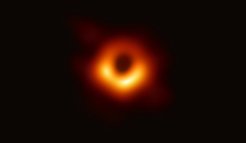Collaborations
BlackHoleCam & Event Horizon Telescope

The predictions from Einstein’s theory of General Relativity (GR) have been successfully tested in the weak and, partially, in the strong gravitational fields. Another prediction of GR is the existence of black holes and the presence of a “shadow” around the event horizon of the black hole. To test GR in these most extreme conditions, the ERC-funded project BlackHoleCam aims at studying the supermassive black hole at the center of our Galaxy, Sgr A*, and M87. Especially, for Sgr A*, three different types of observational experiments hold the promise to test GR: The first experiment involves the imaging the “shadow” cast against the relativistic plasma which surrounds the event horizon. The predicted angular size of the “shadow” (~50 μas) as seen from Earth can be resolved by upcoming Very Long Baseline radio Interferometry (VLBI) experiments at mm-waves such as the Event Horizon Telescope (EHT). The second experiment involves monitor stars and plasma orbiting around Sgr A* with the next-generation near-infrared interferometer GRAVITY at the Very Large Telescope. The third experiment involves the search and subsequent timing for radio pulsars in tight orbit around Sgr A* using radio telescopes (including the Effelsberg radio telescope and the state-of-the-art mm-observatories such as the Atacama Large Millimeter Array, ALMA). The synergy between these three different approaches will eventually enable the measurement of fundamental black hole parameters (mass, spin, and quadrupole moment) with sufficiently high precision to provide fundamental tests of GR (e.g., the no-hair theorem) and probe the spacetime around a black hole in any metric theory of gravity.
BlackHoleCam is a collaboration with Prof. Heino Falcke at the University of Nijmegen, Prof. Luciano Rezzolla at the University of Frankfurt and a number of other partners (see www.blackholecam.org). BlackHoleCam collaborates as a major stakeholder with the Event Horizon Telescope (EHT) Collaboration, and especially all other other scientific departments of the MPIfR. (Millimeter and Submillimeter Astronomy and Radioastronomy / VLBI).
CHANG-ES
Continuum Halos in nearby galaxies - an EVLA survey [homepage of CHANG-ES]
D-MeerKAT
The D-MeerKAT consortium is an initiative to bring together researchers from German universities, Max Planck Institutes and the Jülich Supercomputing Centre in the development of big data management structures, software pipelines and instrumentation to prepare for the next-generation of radio telescopes, such as, MeerKAT, an SKA prototype telescope, SKA pathfinders and eventually the SKA.
Dynaverse
The newly-funded Cluster of Excellence "Our Dynamic Universe" (Dynaverse) combines expertise in astrophysics, informatics and mathematics from across the Universities of Cologne and Bonn and other major partners including the Max Planck Institute for Radio Astronomy with the intention of investigating physical processes that take place on completely different time scales, in order to piece together the evolution of our entire Universe. [more]
European Pulsar Timing Array (EPTA), Indian Pulsar Timing Array (InPTA) & International Pulsar Timing Array (IPTA) and Partners
The MPIfR is a founding member of the EPTA which in turn helped creating the IPTA.
The Large European Array for Pulsars (LEAP) initiated by an ERC Advanced Grant to Prof Kramer, utilizes the European telescopes to synthesize a 200-m dish for monthly pulsar timing observations. The EPTA, hence MPIfR, has intensive collaborations with the established Indian and Chinese Pulsar Timing Arrays (InPTA and CPTA, respectively).
LEGACY

The MPIfR collaborates with the MPI for Gravitational Physics, also known as the Albert-Einstein Insitute (AEI) and colleagues in the Chinese Academy of Sciences (CAS) on the Low-frequency Gravitational Wave Astronomy from Space (LEGACY). Funded by resources from MPG and CAS, the collaboration focuses on methods and techniques to detect gravitational waves at frequencies not accessible to LIGO, using future space-based detectors like LISA and pulsar timing arrays (See EPTA). Especially, the MPIfR collaborates with colleagues at CAS operating the new 500-m telescope FAST, which is the largest telescope on Earth. While it can only see a restricted area of the sky, the combination with the 100-m Effelsberg telescope makes it a powerful tool to search and time pulsars for studies of gravitational physics.
MPG Partner Groups
Two official MPG Partner Groups exist with Prof. Keija Lee and Prof. Lijing Shao, both at the Kavli Institute for Astronomy and Astrophysics (KIAA) of Peking University (PKU) and former members of the group. Prof. Lee shares research interests in gravitational wave research and fast radio bursts (FRBs). Prof. Shao works on gravity research.
MeerTIME
MeerTIME is a five-year program on MeerKAT array by an international consortium that will regularly time over 1000 radio pulsars to perform tests of relativistic gravity, search for the gravitational wave signature induced by supermassive black hole binaries, explore the interiors of neutron stars through a pulsar glitch monitoring programme, explore the origin and evolution of binary pulsars, monitor the swarms of pulsars that inhabit globular clusters and monitor radio magnetars. [more]
TRAPUM
The “Transient and Pulsar with MeerKAT” project (TRAPUM, co-led by the MPIfR and the University of Manchester) will discover numerous new pulsars and transient events. [more]
VdR
The Max Planck Institute for Radio Astronomy is member of the “Association for Data-intensive Radio Astronomy”.

